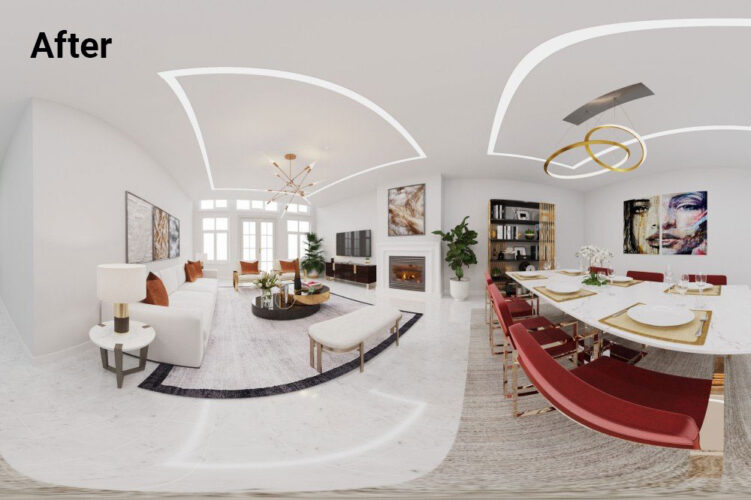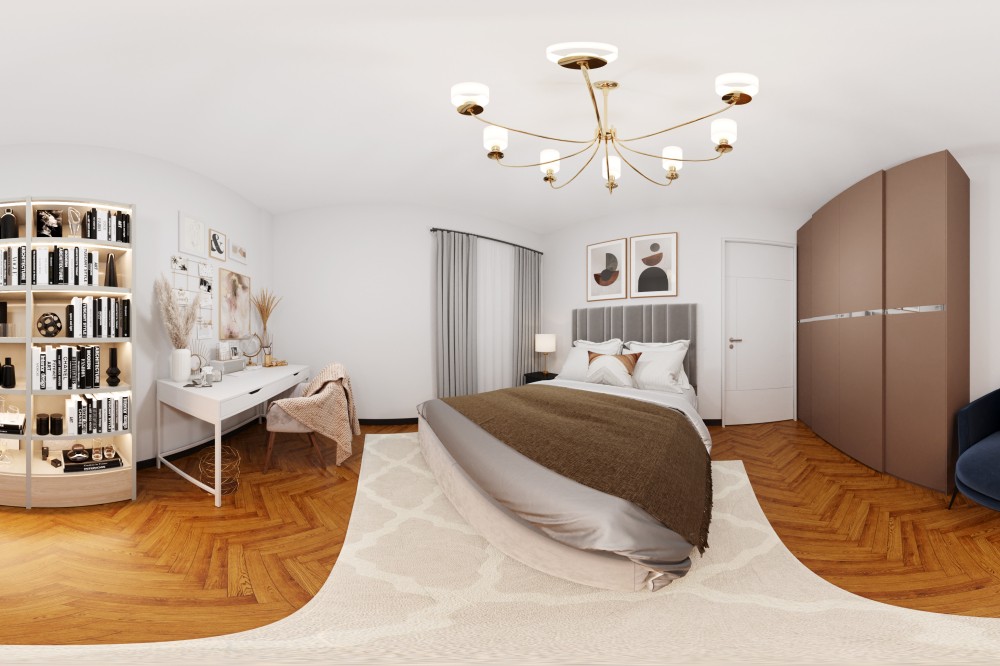Avoiding misleading edits in real estate photos
In today’s digital world, high-quality photos are crucial for attracting potential buyers in the competitive real estate market. These photos create a first impression and play a significant role in a property’s success. However, it’s essential to ensure these images accurately represent the property. Misleading edits, while tempting to enhance a space, can ultimately disappoint buyers and damage trust. This guide aims to equip photographers and realtors with valuable strategies to avoid such edits, ensuring transparency and a smooth buying experience for all parties involved.
Understanding the Impact of Misleading Edits
Deceptive edits can significantly distort a potential buyer’s perception of a property. Imagine a photo showcasing a spacious living room with brightened windows, only to find it cramped and dark during the in-person showing. This creates frustration and wasted time for both the buyer and seller. More importantly, misleading edits can have legal and ethical repercussions. Real estate agents and photographers have a responsibility to present an honest portrayal of the property. Misrepresenting the space through edits could be considered misrepresentation, leading to potential lawsuits or disciplinary action from licensing boards. Finally, misleading edits can severely damage the reputation of both the property and the professionals involved. Disappointed buyers are likely to share negative experiences, impacting the property’s marketability. Similarly, a history of misleading edits can tarnish the reputation of realtors and photographers, making it difficult to attract future clients.
Strategies for Avoiding Misleading Edits
Achieving accurate representation in real estate photos requires a multi-pronged approach. Here are key strategies to ensure transparency and avoid misleading edits:
1. Partner with Professional Photographers
Finding the right photographer is crucial for achieving accurate and captivating real estate photos. Here’s a deeper dive into this strategy:
1.1 Hire Experienced Professionals
Invest in a photographer who prioritizes honest representation over exaggerated enhancements. Here’s how to find such a professional:
- Experience in Real Estate Photography: Look for photographers with a proven track record in real estate. Their portfolio should showcase a variety of properties captured in a realistic and appealing way.
- Understanding of Editing Ethics: Discuss their editing philosophy during the consultation. Ensure they prioritize adjustments that enhance the natural beauty of the property without resorting to misleading manipulation.
- Technical Expertise: While artistic vision is important, a strong understanding of lighting, composition, and technical aspects of photography is equally crucial. This ensures high-quality images that effectively showcase the property’s features.
1.2. Research Portfolios and Reputation
Before finalizing your decision, thoroughly research potential photographers. Here are some key steps:
- Portfolio Review: Spend time examining the photographer’s portfolio website or online presence. Look for consistency in their style and a focus on natural-looking photos that accurately represent the properties.
- Client Testimonials: Read reviews and testimonials from past clients. Positive feedback regarding honesty and realistic portrayal is a good sign.
- Industry Recognition: See if the photographer holds any certifications or awards from recognized real estate photography organizations. This can indicate a commitment to ethical practices and professional development.
2. Emphasize Honesty and Transparency
Building trust with potential buyers starts with open communication between real estate agents and photographers. Here’s how to ensure your message of honesty and transparency is clearly conveyed:
2.1 Clear Communication is Key
From the initial consultation, establish a dialogue that prioritizes accurate representation. Here are some points to discuss:
- Your Expectations: Clearly communicate that truthful portrayal of the property is your top priority. Discuss the type of edits you find acceptable, such as basic exposure adjustments or minor color correction.
- Photographer’s Expertise: Learn about the photographer’s editing philosophy and workflow. Ask them to explain their approach to enhancing photos while maintaining a realistic feel.
- Addressing Concerns: Don’t hesitate to voice any concerns you might have regarding specific editing techniques. Open communication helps ensure everyone is on the same page.
2.2 Establish Editing Guidelines
Developing clear editing guidelines with your photographer provides a roadmap for achieving truthful representation. Here’s what you might include:
- Acceptable Adjustments: Define acceptable editing practices. This could encompass adjustments like:
- Exposure and White Balance: Balancing lighting and color temperature to create a natural look.
- Cropping and Straightening: Improving composition without altering the actual space.
- Minor Noise Reduction: Enhancing image clarity without over-smoothing details.
- Virtual Staging Transparency: If using virtual staging, ensure clear disclosure in the listing description. Potential buyers should be aware of virtually added furniture or décor.
- Restrictions on Manipulation: Clearly outline unacceptable edits, such as:
- Exaggerated Color Enhancement: Altering the natural color palette of the property.
- Distorting Room Size or Layout: Making rooms appear larger or manipulating walls to hide potential limitations.
- Adding Unrealistic Features: Including elements like windows or balconies that don’t actually exist.
3. Utilize Technology Responsibly
The power of editing software can be a valuable tool in real estate photography. However, responsible use is key to maintaining transparency. Here’s a breakdown of this strategy:
3.1 Understand Editing Software Capabilities and Limitations
Both real estate agents and photographers should have a basic understanding of what editing software can and cannot do. This knowledge helps set realistic expectations and avoids venturing into misleading territory. Here’s what to consider:
- Common Editing Tools: Familiarize yourself with basic editing functions like exposure adjustment, white balance correction, and minor blemish removal.
- Advanced Features: Be aware of more advanced features like content-aware fill or HDR blending. While these can be helpful in specific situations, understand their limitations to avoid creating unrealistic results.
- Software Differences: Different editing software offers varying functionalities. Research the capabilities of the software your photographer uses to understand its potential impact on the final image.
By having a foundational understanding of editing software, you can participate in informed discussions with your photographer and ensure edits enhance the photos naturally.
3.2 Avoid Excessive Enhancements
While editing software can improve clarity and visual appeal, resist the urge for excessive manipulation. Here’s how to maintain a realistic approach:
- Focus on Natural Enhancement: Prioritize edits that improve the natural beauty of the property. This could involve adjusting exposure for a brighter and more inviting feel or correcting color temperature for a more accurate representation.
- Maintain Realistic Details: Avoid over-smoothing edits or excessive noise reduction that can remove details and create an artificial look.
- Calibrated Monitor: Ensure your photographer uses a calibrated monitor to guarantee edits accurately reflect the final image viewed by potential buyers.
By implementing these strategies, real estate professionals can ensure photos accurately represent properties, fostering trust with potential buyers and building strong reputations in the competitive market.
Best Practices for Real Estate Photography
Building on the foundation of avoiding misleading edits, let’s explore best practices for real estate photography:
1. Capture High-Quality Images from Multiple Angles
- Invest in high-resolution cameras capable of capturing sharp, detailed photos that showcase the property’s true scale and features.
- Photograph each room from multiple angles, providing a comprehensive view of the space and its layout. This allows potential buyers to virtually explore the property and envision themselves living there.
2. Utilize Natural Lighting
- Whenever possible, prioritize natural light to illuminate the property’s interior. Natural light creates a warm, inviting atmosphere and accurately represents the space’s overall feel.
- If natural light is limited, use artificial lighting strategically, avoiding harsh shadows or unnatural color casts.
3. Highlight Strengths and Limitations
- A skilled photographer can effectively showcase a property’s best features, like spacious living areas or a beautifully designed kitchen.
- However, transparency is key. Don’t shy away from capturing potential limitations, such as a smaller bedroom or a dated bathroom. Honest portrayal builds trust with potential buyers.
4. Consider Before-and-After Comparisons (Optional)
- While not always necessary, using before-and-after comparisons can be a powerful tool for demonstrating the photographer’s skills and commitment to accurate representation.
- Showcase how basic editing techniques, such as adjustments to lighting or exposure, enhance the photo without significantly altering the property’s true appearance.
By following these best practices, real estate photographers can create captivating and informative photos that truthfully represent a property, attracting genuine interest from potential buyers
Conclusion: Building Trust Through Transparency
In today’s digital age, high-quality real estate photos are undeniably important. However, achieving success goes beyond aesthetics. Transparency and accurate representation are essential for building trust with potential buyers and fostering a smooth buying experience.
By understanding the pitfalls of misleading edits, implementing the strategies outlined above, and embracing best practices for real estate photography, real estate professionals can showcase properties truthfully and compellingly. This approach not only benefits buyers but also strengthens the reputation of agents, photographers, and ultimately, the real estate industry as a whole.




